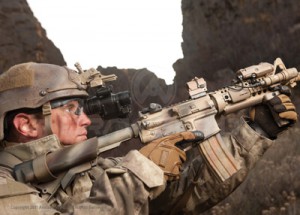There are plenty of myths and rumors surrounding Thermal Night Vision, as it is relatively rare and new to the open market. We’ve gathered five of the most common misconceptions here.
Myth 1. Thermal Imagers are for Military and Law Enforcement members only, it is illegal for civilians to own these devices:
I’ve heard this from all kinds of people. That you shouldn’t even ask for night vision or thermal kit; no one will sell it to you because unless you’re in the armed forces you couldn’t possibly have a legitimate use for it. This is a little narrow-minded, but more importantly its just plain not-true. Civilians in the United States and Canada can certainly buy thermal night vision. There may be restrictions on high frequency models and weapon mounted units, and there is a dedicated line for Law Enforcement, but there is still a wide range of thermal imagers available for the general public. Thermal technology has applications well outside the military, such a search-and-rescue, firefighting, outdoor adventure, or pest control.
Myth 2. All Night vision looks the same, washed out green:
Part of this comes from confusion between night vision devices that are “infrared assisted” and thermal devices that are “Forward Looking InfraRed” Standard night vision devices amplify existing light but are “infrared sensitive” and see infrared light like a flashlight. They see existing visible light, and use IR beacons and illuminators as a light source that only broadcasts to the device. This is not the same as a thermal camera that detects infrared energy signatures! Forward Looking InfraRed isn’t looking at light waves in the same way. Instead it outputs according to internal heat signatures, which creates a high contrast black and white image. Instead of everything being the same green tone but brighter, we separate out different aspects of an image into different brightnesses which effectively highlights anything warm or cool in the scene.
Myth 3. Thermal Night Vision can only be used at night:
The image intensifier tubes in conventional night vision will over expose in daylight, and can actually overheat and damage themselves if hit with bright light like the streetlight in Iraq you see here. This leads to expensive additions like auto-gating so that a image intensifier will shut itself down upon exposure to damaging daylight or bright flashlights. We have none of these problems. In daytime it reads heat exactly the way it would in the dark. The thermal information gathered cannot be “over-exposed” and its highlighting ability is still very valuable in daylight. A target in camouflage or far out will still emit heat that the device will pick up, regardless of whether the sun it out.
Myth 4. Thermal imaging can be applied to any picture or video. I even have it on my phone!
That rainbow color scheme we know from the Predator movies shows up all over the place. Its a super popular filter for youtube videos or phone camera programs. With the varying layers of red hot and blue cold it looks pretty convincing. But it is in no way a real thermal image. Instead the program just interprets regular color differences and layers a rainbow gradient over them, making a “fake” type of image. No heat information is being recorded or presented when you apply that, its just some interesting colors over a standard photo. With a fake image parts of a face will look cold and other parts will look hot, even though its all the same skin. Also, try using that cellphone feature at night and you’ll see immediately how that program needs light to do anything.
Myth 5. Thermal Night Vision technology is useless in warm climates. When everything is hot it can’t see anything!
Thermal night vision is based around the idea that different things emit different amounts of radiation. So its true that when things are the same temperature they will appear as the same tone. I’ve interview soldiers who’ve returned from using Thermal Night Vision in Afghanistan, and sure enough there are times of day when the ground is the same temperature as body heat. In those conditions, Thermal Night Vision can be tricky, but that is only for fifteen minutes a day in a hostile environment. You can still use thermal night vision units in warm locales by changing your pallets to change how the camera displays existing temperature difference. Choosing white-hot or black-hot can help differentiate warm and cool objects, or the Instalert setting which will highlight the hottest objects in the scene. There are three levels of Instalert, where you might choose the most sensitive for a cool environment and the least sensitive for a warm one.
This article comes from scoutbasecamp edit released

